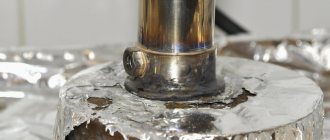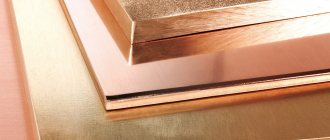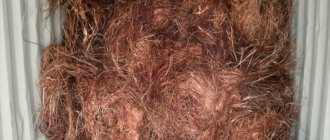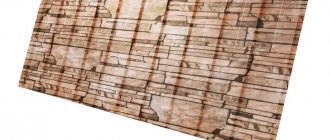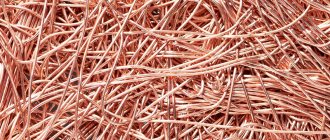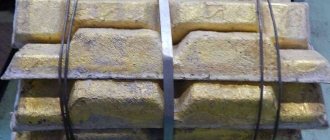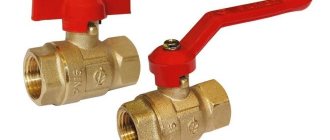Taps, hardware, pipes, decorative interior items and many other products are made from brass. This material is obtained by fusing copper, zinc (in different proportions) and various additives.
Soldering brass ensures a reliable and high-quality connection of parts. Soldering involves the use of a special tool in the form of a gas torch, as well as solder made from a mixture of tin and lead. In some cases, tin alone is used to make brass solder.
Advantages and disadvantages
If you have the necessary tools and materials, and after learning the basic techniques for handling brass, you can solder this material yourself.
Soldering brass products has several features. This technology involves the use of specially prepared solder, which is introduced into the gap between the parts and plays the role of a “grasping” element. In addition, the equipment through which the solder material is melted is essential.
Typically, a gas torch is used for soldering, which ensures that the solder wire melts at temperatures lower than the melting point of the brass itself. Using this technology, it is possible to reliably solder individual workpieces of similar or dissimilar materials in structure.
In some cases, the use of brass soldering is the only possible way to obtain permanent contacts.
It is unacceptable to compare soldering with welding procedures in which each of the metals being fused is subject to melting. In this case, only hard solder with tin is exposed to thermal effects, and the condition of the parts being connected remains unchanged.
This feature allows you to process brass products of very small size and weight without causing any damage to them.
When carrying out soldering, it must be taken into account that this process involves the use of softer consumables than when welding. As a result, the joints obtained by soldering are considered less strong compared to welded seams.
In cases of working with brass, zinc completely evaporates from the solder body (due to its strong heating), as a result of which the seam becomes porous, which significantly reduces the quality of the joint formed.
In addition, when soldering brass parts, it is important to correctly select their relative position (in this case, preference is given to “overlapping” joints).
Application
Modern technologies for processing copper and zinc alloys are widely in demand in such industries as:
- electronics and electrical engineering;
- instrument making and tool production;
- production of refrigeration and ventilation equipment.
If you have everything you need (solder of the required quality, flux and soldering torch), you can tin the brass surfaces in order to protect them from corrosive destruction. The tinning procedure is also in demand when repairing heating and plumbing systems made on a brass basis.
Depending on the type of solder used for soldering, connections are divided into high- and low-temperature. This division allows the use of more refractory joints for soldering workpieces operated at high temperatures.
Using high-temperature soldering is impossible at home, since this situation requires special equipment.
Features of soldering homogeneous workpieces
In everyday life, there is often a need to solder two brass blanks that are identical in structure. In this case, the correct choice of flux composition, which differs from the traditional combination of rosin and alcohol, becomes of paramount importance.
Due to the low activity of the components, a conventional composition will not be able to dissolve the oxide film that forms on the surface of brass. So for the soldering option under consideration, a more active flux based on chlorine and zinc will be required.
All the details of its preparation can be found in the table, which shows several types of zinc chloride mixtures.
In addition to the types of flux considered, when soldering brass, compositions based on borax and potassium fluoride-boron salt can be used. Mixtures prepared from them occupy no more than 5% of the total volume of the solder bath and have excellent activity indicators.
Activity refers to the ability to create ideal conditions for the penetration of molten solder into the gaps between parts during soldering.
Along with the problem considered, we should not forget about a competent approach to the selection of solder supplied to the joint in the form of calibrated wire of one composition or another.
In the case where soldered brass products are intended to be used in a gas environment, it is advisable to use special types of solders made on the basis of copper phosphate and silver alloys. They are also suitable for soldering red brass with a high percentage of copper content.
Sometimes wire made from brass itself is used as solder. However, in this case, it is possible to solder a brass part only if the melting point of the brass wire is lower than the same indicator for the workpieces being processed.
Soldering brass at home - rules and features
03.11.2017
Brass is a widely used alloy for creating various products, so the question of how to work with it is relevant for many craftsmen. The process has certain features and difficulties; it can be performed both at home and using industrial methods. If you follow the rules, brass soldering can be done by anyone.
Nuances of technology
Brass is an alloy in which the main components are copper and zinc, and the additional elements are tin and aluminum. Metal products are always used in everyday life. When you need to connect two different objects, you resort to soldering. The method has some nuances that you should be aware of before starting the work.
The main feature of the process is the active evaporation of zinc due to exposure to very high temperatures. As a result, a dense film quickly forms, especially if the percentage of zinc in the alloy is more than 15%. It is not possible to destroy it even with the help of rosin and alcohol. Therefore, when soldering brass, it is important to use special fluxes.
It is also necessary to carefully study all stages of the process, since this is the only possible option to firmly connect two different objects into one. The essence of soldering is that molten solder is introduced between the two parts being connected, which holds them together. The main condition of the process is this: the heating temperature of the connecting element must be less than the melting temperature of the objects being connected.
Hard soldering produces stronger, heat-resistant seams. The technology is carried out according to standard rules. The advantage of the method is that you can connect objects from different materials. At the same time, their surface, structure and properties do not change, as happens during welding.
Preparatory process
Before connecting brass products, it is necessary to prepare them. To achieve the most effective result, you need to use special equipment - a gas burner. Then the soldering will be reliable, and the joint will not be noticeable.
To treat brass parts, use oxalic acid or various household products. When working with acid, you should wear gloves and do not breathe over the solution, which is obtained in the following proportion: 20 grams per liter of hot or cold water. The solution is prepared in a plastic container to avoid exposure to other metals. It is needed to clean the alloy; after processing, the product is wiped and left to dry.
General procedure
Before you start soldering brass parts yourself, you should thoroughly clean them of foreign deposits and contaminants. Next, you need to place them on a fire-resistant substrate, the function of which can be performed by river pebbles poured into an old bucket.
The general procedure for soldering brass can be represented as follows.
- first, the place of the intended connection of two parts is treated with a flux of suitable composition, after which finely planed crumbs of solder material are poured onto it;
- after this, you can start heating the brass (only at the joint!) using a previously prepared burner;
- After melting the solder material and filling the gaps between the parts with liquid composition, turn off the burner and wait for the joint to cool down.
Read also: The chainsaw doesn’t start well when it’s hot.
During the soldering process, overheating of the workpieces, which can cause their deformation, is unacceptable. In general, independent brass soldering is not something completely inaccessible.
To master this technology, it is enough to correctly select all the necessary consumables and strictly follow the recommendations given.
Brass products are often found in everyday life. When repairing them, owners have to resort to soldering technology. Since this method of joining metals has specific features, beginners may have difficulties during the work. Therefore, they are interested in how to solder brass. If you know the technology and follow the recommendations of specialists, anyone can cope with this procedure. You will find information on how to solder brass at home in this article.
What are the features of using copper alloys?
Many beginners ask the question of how to solder bronze and brass. The interest is due to the fact that soldering is associated with some difficulties. During thermal exposure, active evaporation of zinc alloy occurs, resulting in the formation of a dense film of zinc and copper oxides. It is quite difficult to destroy it. According to experts, rosin will not cope with this task.
The master will have to use special fluxes. If you use tin-lead solder, there is a risk that the joint will have low mechanical strength. Unlike copper soldering, in this case the strength indicator will be one and a half times lower. The reason for this is evaporating zinc. The choice of soldering method for bronze parts will depend on its composition. Bronze with a high content of tin and nickel should be soldered using tin-lead solders. Bronze containing aluminum and beryllium is best joined with special solders and fluxes.
What characteristics should a flux for soldering copper pipes have?
The quality of the seam and the soldering strength of copper pipes are influenced by the characteristics of the flux and their correct selection, taking into account the composition of the solder and, consequently, its melting point. Fluxes are substances that actively enter into chemical reactions with oxides and are inert to the elements that make up the solder. Their melting point is lower than that of copper.
Positive qualities of flux for soldering copper pipes:
- easy to apply to the surface;
- has a uniform consistency;
- wets the surface well;
- cleanses from oxides;
- has a viscosity lower than that of solder;
- does not collapse when heated;
- after soldering, it spreads evenly over the surface of the seam;
- does not interact with copper;
- does not form a connection with solder.
The molten flux floats out without remaining in the seam. It bonds to the solder, covering the soldering area and protecting the seam from oxidation until it cools completely. It should lie evenly on the pipe when cold and clean it of oxides when heated, without forming pores.
About fluxes
Their task is to remove the resulting film from the surface of the metals being joined and prevent its further appearance. According to expert reviews, rosin is suitable for soldering copper products. The situation is different with brass. How to solder this alloy correctly? Which flux should I choose? Beginners often ask such questions. Experienced craftsmen advise using a more “aggressive” flux than rosin. Since metals are used as additives in the production of brass, fluxes with different compositions should be used for soldering. To work with the most common brands of brass L63 and LS59, a flux containing zinc chloride and boric acid is intended. For LKS80 with lead and silicon, the best option would be a borax-based flux containing boron, potassium and fluorine. Ready-made formulations are available on the shelves of specialized stores. Experts recommend paying attention to PV-209, PV-209X and Bura fluxes. Anyone who wants to save money can prepare flux at home.
Fluxes for brass soldering
This flux for soldering brass can be purchased either ready-made or made with your own hands. To make your own flux, you will need boric acid, borax powder and plain water. In this case, boric acid is mixed with borax (one to one), and then water is added to the composition at the rate of 5 mg for each gram of powder.
As for ready-made flux options for soldering brass, today they are widely used:
- Ready-made Borax flux, specially designed for high-temperature soldering of parts;
- Fluxes of brands PV-209 and PV-209X;
- Chemet FLISIL-NS-Pulver powder flux and Chemet FLISIL-NS-Paste paste flux.
About solder
With the help of this molten metal soldering is carried out. In a liquid state, it penetrates into the metals being soldered and then cools, resulting in a connection. The melting temperature of the solder must be lower than the melting temperature of the metals themselves. For those who are wondering whether it is possible to solder brass with tin, experienced craftsmen recommend using solder with good adhesion. Conventional alloys containing tin and lead are best used in cases where high mechanical strength is not required. Solder is also suitable when the appearance of the joint is not important.
What kind of solder to solder copper pipes
Solder for soldering is selected depending on its consistency:
- soft;
- solid.
Low-melting materials form the basis of soft solders; they are worked with when heated to 450⁰C. They are based on low-melting metals - tin and lead. For soldering soft joints, solders made of metal that reacts with tin are available:
- zinc;
- lead;
- cadmium
As well as compositions from low-melting substances:
- lead-silver;
- indium;
- bismuth
The soldering process occurs at low temperatures. The disadvantage is the relatively low bond strength.
The connection of water supply pipes and parts of critical structures is carried out with solid fluxes having a melting point above 450⁰C, mainly in the range of 700–900⁰C. The composition is based on copper and silver with the addition of phosphorus:
- copper-phosphorus;
- copper-zinc;
- silver
When melted, they flow well into the gap, penetrate into the pores and connect parts at the molecular level.
For high-temperature soldering with refractory solders, fluxes containing borax (sodium borate) and boric acid are used. Fluorides and chlorides are used as additional components. Borax melts at 743⁰C, but it is hygroscopic. Before use, the substance must be heated and dried to remove water crystals. The temperature in the oven should be within 450⁰, holding time 40 - 60 minutes. When boric acid is added to borax, it is also dried, all components are mixed and ground into powder. Should be stored in a closed container, away from air and moisture.
Copper pipe with solder
About solder compositions
The choice of solder depends on the brand of brass. Silver solders PSr12-PSr72, brass PMC36-PMC54 and copper-phosphorus are recommended for brass with a predominance of copper in its composition. If there is more zinc in the metal, then you need to work with silver solders from PSr40 no lower. With phosphorous compounds, weak zinc phosphorus compounds are formed, which reduces the mechanical strength of the solder. For parts that are not subject to shock and vibration during operation, MPC brass solders are suitable. Note that brass can easily dissolve, so craftsmen using silver and phosphorus solders should reduce the heating and soldering time.
To work with permanently fixed parts (radiators and pipes), experienced craftsmen recommend using special hard solders with complex compositions. According to numerous consumer reviews, L-CuP6, which melts at a temperature of 730 degrees, is very popular. You can also prepare solder at home.
Welding brass in garage conditions. Information about Welding Brass
Brass is an alloy of copper and zinc; other alloying elements may be present in small quantities. And since zinc is a low-melting metal, its melting point in its pure form is 400 °C with a “tail”, so welding brass is an unpleasant and not harmless task.
Zinc burns, releasing burning and an unpleasant odor. To carry out the work, you must definitely acquire a respirator, which is unlikely to completely protect you from harmful emissions, but it is still better than without it at all. Be that as it may, for a one-time job, a respirator will be quite enough. Zinc is bound to copper at the molecular level, which leads to a reduction in the melting point of brass by half when compared with pure copper. Brass melts at a temperature of about 900 °C.
In connection with the above, it is reasonable to conclude that brass is still better to solder. Soldering works best when you have carbide solder in your hand, but with a melting point still lower than that of brass. Copper-phosphorus solders are best.
The oxide film on the surface of a non-ferrous metal prevents the solder from wetting, spreading and setting on the surface of the part, so fluxes are used that remove oxides. The most famous flux, which everyone who does welding or soldering has heard of, is borax .
It can always be purchased at the nearest store, and it will be useful not only for soldering brass, but also all copper alloys in general, as well as steel and cast iron. There is also a special flux that will help when working with brass products - PV209, it is more often used in production.
For some reasons, copper soldering is still being replaced by welding. What could be the reasons?
- First, there are people who are distrustful of soldering. In some cases, they may actually be right, especially if the part will experience some serious loads during operation, which will twist, bend and otherwise test this part’s strength. Soldering with copper-phosphorus solders gives excellent strength to the solder joint, more expensive silver solders provide even higher strength (you can find the corresponding values of the “time sigma” - tensile strength and other characteristics on the Internet), but soldering will never compare in strength to welding. The latter gives the highest strength characteristics.
- The second reason is the customer’s possible requirements for the uniformity of the base metal and the weld metal in color. When soldering, color differences will definitely be more pronounced, since a weld pool is not formed and there is no mixing of metals. Differences are also possible during welding, but they are still minimal or absent altogether (depending on the welding technology and the filler materials used).
- The third reason will sound trivial - they cook because there is no way to solder, since the only equipment available is a welding machine.
It should also be noted that brass is welded using most of the known welding methods:
Special welding methods include laser and ultrasonic.
If we talk about the basic welding methods that are used not only in production, but also in the garage by our Kulibins... The easiest way to weld brass is with an oxygen-acetylene flame. When working with TIG, brass hisses a lot, as it quickly heats up to its boiling point, and the process itself is described as quite complex.
Not everyone succeeds in obtaining some acceptable result using TIG, but if you follow the technology and acquire the necessary skills, it is still possible to master TIG of brass. At the same time, the quality of the seams is high. And the most interesting case is, of course, welding with electrodes. It is recommended to use electrodes with a rod made of brass LK80-3, LMts59-02 or bronze KMts3-1 (international name CuSi3).
Just forgot to write where to get such electrodes? It is unlikely that they are sold in the nearest store! The solution seems to be welding with a graphite electrode.
In all cases, the theory is that the more alloying elements in the filler rod that are deoxidizing agents, the better. Deoxidizing agents are, for example, elements such as silicon or manganese. They bind free oxygen in the melt and bring it to its surface in the form of slag.
Thus, the harmful component is removed from the metal and, as a result, the number of defects is reduced - there is no porosity or it is reduced to a minimum - single pores, cavities. It is difficult to say how much the deoxidizers that are in the welding wire affect the quality of the weld (brass) in terms of its defect-free quality in practice.
For example, when surfacing M1 copper with an M1 rod onto electrical steel type 10895 or 10864.10865 with an oxygen-acetylene or oxygen-propane torch, serious porosity of the deposited layer is observed - private chains of pores. Moreover, the greater the porosity, the higher the intensity of the flame and its speed.
Defects in surfacing (or weld) most likely appear due to the fact that the molten metal is “blown” by a high-speed flame and the presence or absence of deoxidizers in the additive composition is unlikely to change anything for the better. The situation is radically changed, for example, by welding in argon - here argon is supplied at a lower speed and forms a cloud of gas around the weld pool. As a result, the deposited layer has virtually no pores.
How to do it
When soldering brass, it is best to use silver solder. It is desirable that the melting site be a special crucible adapted for significant thermal effects. Contact carbon elements for trolleybuses can be used as a material for crucibles. When heated, they are of no value, and a home craftsman can use them to make solder. In this product, a recess of 20 x 20 mm should be made. Next, a groove should be made to it. It will be easier to remove the solder if its width is 0.5 cm.
Solder is made from silver and copper (2:1). After taking the required amount of metals, they should be placed in a crucible. Their heat treatment is carried out with a gas burner. Some craftsmen pre-crumb the consumables. In this case, the melting procedure is much simpler. Next, a steel or ceramic (porcelain) rod is added to the composition. You can solder brass when the homemade solder has completely hardened.
Read also: How to calculate taper in a drawing
Bronze welding
Bronze is welded mainly when correcting defects in cast products. Welding can be carried out with a carbon or metal electrode, as well as with a gas flame.
Bronze arc welding
When welding with a carbon electrode, cast bronze rods with a diameter of 5-12 mm of the same chemical composition as the metal being welded are used as filler metal.
When welding with a metal electrode, special coatings are applied to the electrode rods. The composition of some of the most common electrode coatings is given in table. 26. Welding with a metal electrode is performed on a direct current of reverse polarity, and with a carbon electrode - on a direct current of direct polarity. It is recommended to heat massive parts to 350-450°C before welding.
Gas welding
The burner tip is taken at the rate of 100-150 l/h of acetylene per 1 mm of metal thickness. The flame should be normal; filler rods – similar in chemical composition to the metal being welded. To weld aluminum bronzes, you can use fluxes designed for welding aluminum; For other bronzes, you can use fluxes designed for welding copper. Gas welding of bronze is recommended to be carried out with preheating to 350-450 ᴼС.
How to perform soldering with a gas torch
How to solder brass? The procedure is as follows:
- Before starting the process, the metals must be heated. This work is performed on heat-resistant materials. Experts advise using an asbestos plate.
- The parts to be soldered must be aligned with each other.
- Wipe the surfaces at the soldering site thoroughly with flux.
- Cut silver solder. Ultimately, it should be in the form of shavings that should be poured onto the junction of the metals.
- Adjust the flame in the gas burner. To set the solder to metal surfaces, the joint is first heated with low heat.
- Set the gas burner to 750 degrees for main heating. A red tint should form on the brass surface. Solder fills all the gaps, then it spreads throughout the entire joint.
- Turn off the burner and allow the product to cool down. The procedure is considered completed correctly if the result is a seam that differs little from metal.
- Wash the joint to remove any remaining flux.
How to solder brass with a soldering iron
This method is the most common because it is the easiest to perform. For those who do not know how to solder brass with a soldering iron at home, experts recommend following the following algorithm of actions:
- At the very beginning, you need to clean the parts to be connected. Metal surfaces must be free of various foreign deposits and contamination.
- Place the parts on a special fireproof stand. You can make it at home using improvised materials.
- To remove all defects in the brass surface, treat the joint with flux.
- Sprinkle crumbs of solder on top.
- Warm up with a soldering iron.
Very often, beginners ask the question of how to solder copper to brass with hard solder. Experts advise using low-temperature soldering, which can provide a high-quality connection. For this purpose, you will need a soldering iron with a power of no more than 100 W and phosphoric acid. Before work, the surface of the product is thoroughly degreased and the oxide film is removed from it. It is better to connect metals using POS60 tin-lead solder. To start soldering brass, the tool should be warmed up well.
To work with silver solders, you will need a soldering iron, the power of which varies from 0.5 to 1 kW. Degreasing is carried out with flux - concentrated orthophosphoric acid. Borax-based flux is also considered quite effective. In the soldering zone, a temperature of at least 500 degrees is formed.
Works with stainless steel
According to numerous reviews, home craftsmen often have the opportunity to solder stainless steel with brass. Since the presence of nickel and chromium in the compositions of steel alloys does not exceed 25%, working with such materials is less labor-intensive. In addition, this composition ensures reliable connection of stainless steel parts with other metals.
The exceptions are magnesium and aluminum. If the stainless steel has a significant nickel content, then as a result of its heating to 700 degrees, carbide compounds are formed. The longer the heating, the more intensely they form. For this reason, soldering should be done as quickly as possible. The risk of formation of these compounds will be minimal if titanium is added to the alloy during soldering. According to experienced craftsmen, you should be especially careful with riveted stainless steel. This is due to the fact that cracks may appear on the surface of the metal. To prevent their formation, soldering is performed after preliminary annealing of the parts.
Types of flux
Based on the degree of activity and melting point, the following types of flux are distinguished:
- non-corrosive;
- slightly corrosive;
- corrosive.
Non-corrosive compounds exhibit weak activity in removing oxides and are used to a limited extent. Flux is used for soldering copper pipes and for the restoration of products coated with silver and patterned with tin and copper. Melts at temperatures up to 300⁰. The basis of non-corrosive fluxes are:
- rosin and other resins of plant origin;
- wax;
- petrolatum.
The melting point of most of them is below 300⁰.
Low-corrosive fluxes are used to join parts made of copper alloys. They are able to remove oxide film and have a melting point within 450⁰. The main composition is mineral oils and fats, acids. Fluxes are produced chemically. Rosin is added to the composition to weaken the anti-corrosion reaction. When heated, they gradually evaporate. They are used for hard-to-reach connections where it is difficult to clean the surface from flux.
Corrosive compounds are made from inorganic acids, chloride and fluoride compounds. Used for high-temperature soldering of copper, steel, non-ferrous metals.
Petrolatum
Progress
Soldering stainless steel is performed as follows:
- First, the surface is thoroughly cleaned with sandpaper or a file.
- Next, the soldering area is treated with flux, namely soldering acid.
- Then the surfaces need to be tinned - apply a thin layer of solder containing tin and lead to them. It happens that it is not possible to apply solder the first time. In this case, you will have to use a brush containing metal strands. They will be much more convenient to remove the oxide film that prevents tinning.
- Using a soldering iron and solder, solder the parts.
